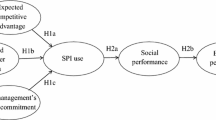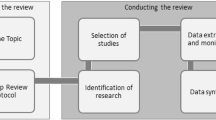Abstract
This research note advances understanding of the possible link between social and financial performance by using a financial-halo- removed measure of quality of management as control variable, along with more traditional controls of size, risk, and industry. The control, quality of management, is found to be highly associated with financial performance. Corporate social performance, measured both as a single indexed variable and as treatment of separate primary stakeholders (product/customer, employees, environment, and community), produces negligible or insignificant relationships with financial performance.
Similar content being viewed by others
References
Alexander, G. and R. Buchholz (1982) ‘Corporate social responsibility and stock market performance.’ Academy of Management Journal 21, 479–486.
Aupperle, K. E., A. B. Carroll, and J. D. Hatfield (1985) ‘An empirical examination of the relationship between corporate social responsibility and profitability.’ Academy of Management Journal 28 (2), 446–463.
Brenner, S. and P. Cochran (1991) ‘A stakeholder theory of the firm.’ Proceedings of the International Association of Business and Society. Sundance, UT.
Brown, B. and S. Perry (1994) ‘Removing the financial performance halo from fortune's “most admired” companies.’ Academy of Management Journal 37 (5), 1347–1359.
Brown, B. and S. Perry (1995) ‘Focal paper: Haloremoved residuals of Fortune's “responsibility to the community and environment” - a decade of data.’ Business and Society 34 (2),199–215.
Cochran, P. L. and R. A. Wood (1984) ‘Corporate social responsibility and financial performance.’ Academy of Management Journal 27, 42–56.
Coffey, Betty S. and Gerlad E. Fryxell (1991) ‘Institutional ownership of stock and dimensions of corporate social performance: an empirical examination.’Journal of Business Ethics 10, 437–444.
Freeman, R. Edward (1984) Strategic Management: A Stakeholder Approach. New York: Basic Books.
Graves, S. B. and S. A. Waddock (1994) ‘Institutional owners and corporate social performance.’ Academy of Management Journal 37 (4), 1034–1046.
Jones, Thomas (1995) ‘Instrumental stakeholder theory and paradigm consensus in business and society: advances on the methodological front.’ Proceedings of the Annual Meeting of the International Association for Business and Society. Vienna, Austria.
Mahapatra, S. (1984) ‘Investor reaction to a corporate social accounting.’ Journal of Business Finance and Accounting 11 (1), 29–40.
McGuire, J. B., A. Sundgren, and T. Schneeweis (1988) ‘Corporate social responsibility and firm financial performance.’ Academy of Management Journal 31 (4), 854–872.
McGuire, Jean B., Thomas Schneeweis, and Ben Branch (1990) ‘Perceptions of firm quality: a cause or result of firm performance?’ Journal of Management 16 (1), 167–180.
Shane, P. B., and B. H. Spicer (1983) ‘Market response to environmental information produced outside the firm.’ LVIII (3), 521–536.
Spicer, B. H. (1978) ‘Investors, corporate social performance and information disclosure: an empirical study.’ The Accounting Review LIII (1), 94–111.
Starik, Mark (1995) ‘Should trees have managerial standing? Toward stakeholder status for nonhuman nature.’ Journal of Business Ethics 14, 204–217.
Ullmann, A. (1985) ‘Data in search of a theory: a critical examination of the relationships among social performance, social disclosure, and economic performance of U.S. firms.’ Academy of Management Review 10 (3).
Waddock, S. A. and S. B. Graves (1994) ‘Industry performance and investment in R&D and capital goods.’ The Journal of High Technology Management Research 6 (1), 1–17.
Waddock, S. A. and S. B. Graves (1997a) ‘The corporate social performancefinancial performance link.’ Strategic Management Journal 8 (4), 303–319.
Waddock, S. A. and S. B. Graves (1997b) ‘Quality of management and quality of stakeholder relations: are they synonymous?’ Business and Society 36 (3), 250–279.
Wokutch, R. E. and B. A. Spencer (1987) ‘Corporate saints and sinners: the effects of philanthropic and illegal activity on organizational performance.’ California Management Review 29, 77–88.
Wood, Donna J. and Raymond E. Jones (1995) ‘Stakeholder mismatching: a theoretical problem in empirical research on corporate social performance.’ The International Journal of Organizational Analysis 3 (3), 229–267.
Author information
Authors and Affiliations
Rights and permissions
About this article
Cite this article
Graves, S.B., Waddock, S.A. A Look at the Financial-Social Performance Nexus when Quality of Management is Held Constant. International Journal of Value-Based Management 12, 87–99 (1999). https://doi.org/10.1023/A:1007770406555
Issue Date:
DOI: https://doi.org/10.1023/A:1007770406555




